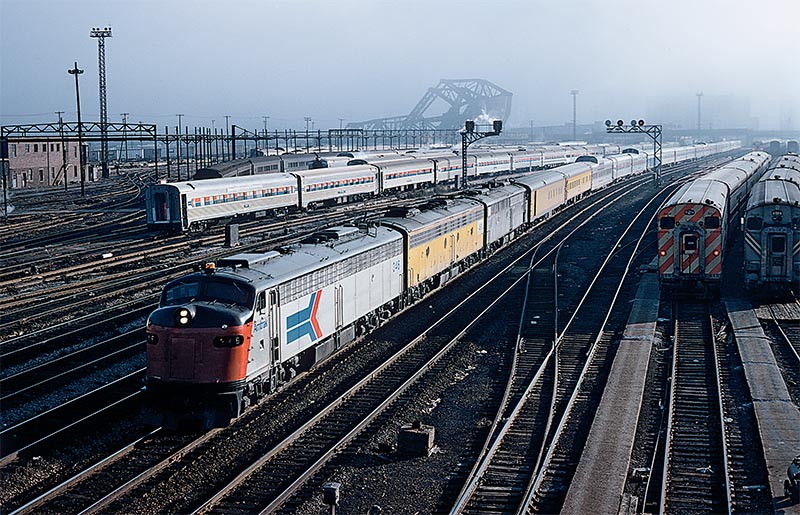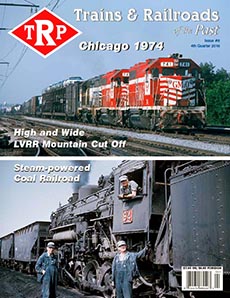Forty-two years ago I had a railroad photo adventure in Chicago. While spending the month of July in the Windy City doing research for my master’s thesis in U.S. History, I took a little time off to make occasional weekend forays to some busy junctions and station platforms. A 23-year-old with little photographic skill and knowledge of the area’s vibrant railroad scene, I nevertheless managed to take a few passable images of nine fallen flags (Illinois Central Gulf, Rock Island, Chicago & North Western, Milwaukee Road, Baltimore & Ohio, Chesapeake & Ohio, Baltimore & Ohio Chicago Terminal, Gulf Mobile & Ohio and Burlington Northern), including commuter rail equipment known as Highliners, Scoots, and Dinkies.
Nearly everything I saw has since changed or disappeared, but I still have fond memories of Chicago in 1974. This article will describe my adventures that summer and also will include photos taken by other railfans of railroad operations that I missed, along with an interesting peek back to 1964 to see how much Chicago area railroading had changed in a decade.
My trip to the city was by train. From our small two-bedroom apartment in Lawrence, Kansas, my wife drove me to the modest ex-Santa Fe depot that Amtrak was using. Around 4:00 a.m., I boarded Amtrak train #16, the eastbound Lone Star, showing the conductor my one way coach class ticket, which cost around $24. The fare sounds cheap, but it was equal to $120 in today’s money, and I was only making $2700 that year as a teaching assistant. Traveling over Santa Fe tracks, this long-distance passenger train deposited me at Chicago’s Union Station the following afternoon. Although I had made rail trips from Oklahoma City to Chicago in 1970 and 1971 with my railfan friend Paul Walters, the summer of ‘74 adventure was the first on my own, a daunting experience because I had never spent time in a big city by myself…
 A southbound Illinois Central Gulf piggyback train pulled by two GP40’s and a Gulf, Mobile & Ohio GP30 passes the ICG commuter station platform at 59th Street in Chicago, Ill., in July 1974. This location was my first and most convenient place to take train pictures, since my dorm room at the University of Chicago was a short walk west of here. Although the “Gulf” has been added to the corporate name, these diesels haven’t been updated, yet. Photo by Carl Graves
A southbound Illinois Central Gulf piggyback train pulled by two GP40’s and a Gulf, Mobile & Ohio GP30 passes the ICG commuter station platform at 59th Street in Chicago, Ill., in July 1974. This location was my first and most convenient place to take train pictures, since my dorm room at the University of Chicago was a short walk west of here. Although the “Gulf” has been added to the corporate name, these diesels haven’t been updated, yet. Photo by Carl Graves
 A push-pull commuter train powered by brand new North West Suburban Mass Transit District (NWSMTD) F40C No. 40 will soon be terminating as it arrives in Chicago in July 1974. These unique diesels were built by EMD in 1974 for two Milwaukee Road commuter lines and numbered 40-54. They eventually were absorbed by Metra and renumbered to 600-614. Notice the signature elevated train zipping above the bi-levels. Photo by Alan Bradley, collection of Kevin EuDaly.
A push-pull commuter train powered by brand new North West Suburban Mass Transit District (NWSMTD) F40C No. 40 will soon be terminating as it arrives in Chicago in July 1974. These unique diesels were built by EMD in 1974 for two Milwaukee Road commuter lines and numbered 40-54. They eventually were absorbed by Metra and renumbered to 600-614. Notice the signature elevated train zipping above the bi-levels. Photo by Alan Bradley, collection of Kevin EuDaly.
 In September 1974, Alco C415 centercab No. 417 and elderly EMD NW2 No. 4901 share a ride on the Joliet, Ill., turntable. The EMD switcher was built for the Pittsburgh & Lake Erie in 1947 and the C415 was built for the Rock Island in 1966. There were only 26 Century 415’s constructed and the Rock picked up ten of them. Notice the unusual bend in the exhaust pipe — it appears to be a feature designed to improve visibility and keep the exhaust from blowing back into the crewmen’s faces. Kodachrome by David Phillips, collection of Kevin EuDaly.
In September 1974, Alco C415 centercab No. 417 and elderly EMD NW2 No. 4901 share a ride on the Joliet, Ill., turntable. The EMD switcher was built for the Pittsburgh & Lake Erie in 1947 and the C415 was built for the Rock Island in 1966. There were only 26 Century 415’s constructed and the Rock picked up ten of them. Notice the unusual bend in the exhaust pipe — it appears to be a feature designed to improve visibility and keep the exhaust from blowing back into the crewmen’s faces. Kodachrome by David Phillips, collection of Kevin EuDaly.
 Amtrak passenger trains looked pretty interesting in 1974. The “pointless arrow” was familiar, but mixed in with a zillion other colors and schemes from other roads. This western train powered by an A-B-A set of EMD E-units wearing three different schemes leads off with icebreaker E8A built for the Burlington as their 9947B. The metal apparatus sticking up at the rear of the unit is designed to break icicles off of tunnels in order to save the glass on the dome cars. Yes, look at the beautiful dome cars both on this train and in the Chicago coach yard in this January 1974 scene. Photo by Alan Bradley, collection of Kevin EuDaly.
Amtrak passenger trains looked pretty interesting in 1974. The “pointless arrow” was familiar, but mixed in with a zillion other colors and schemes from other roads. This western train powered by an A-B-A set of EMD E-units wearing three different schemes leads off with icebreaker E8A built for the Burlington as their 9947B. The metal apparatus sticking up at the rear of the unit is designed to break icicles off of tunnels in order to save the glass on the dome cars. Yes, look at the beautiful dome cars both on this train and in the Chicago coach yard in this January 1974 scene. Photo by Alan Bradley, collection of Kevin EuDaly.
 Utilizing trackage rights over the Chicago & North Western near Deval Tower, a high priority freight consisting of auto parts and tri-levels has a pair of Milwaukee Road SD40-2’s for power. Note the semaphores on the signal bridge. Photo by Carl Graves
Utilizing trackage rights over the Chicago & North Western near Deval Tower, a high priority freight consisting of auto parts and tri-levels has a pair of Milwaukee Road SD40-2’s for power. Note the semaphores on the signal bridge. Photo by Carl Graves




